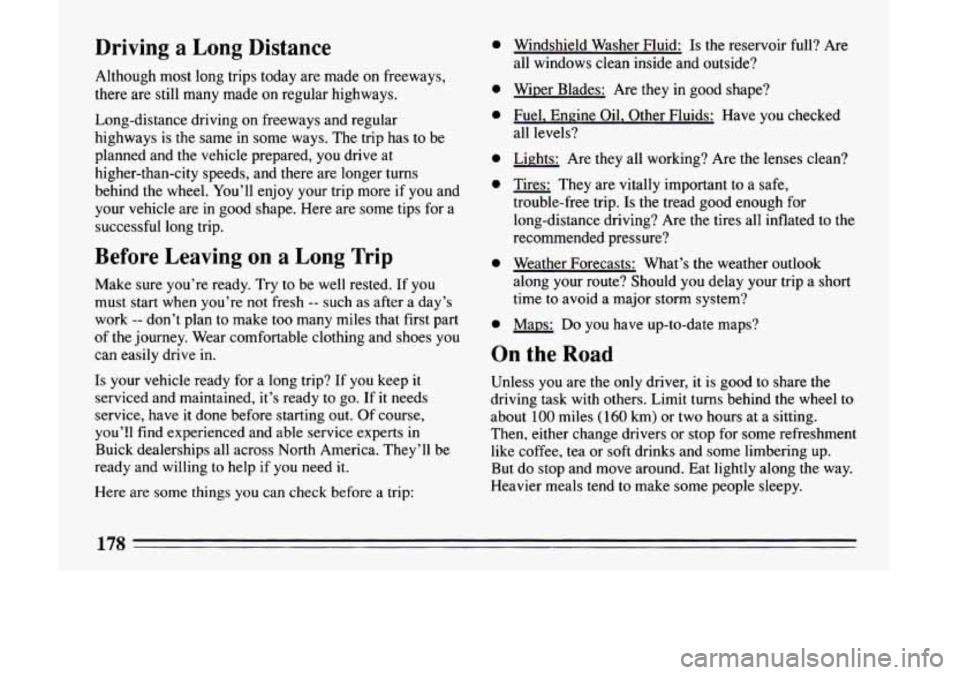1993 BUICK LESABRE wiper fluid
[x] Cancel search: wiper fluidPage 90 of 324

For steady wiping at low speed, turn the band away
from you to the
“LO” position. For high speed wiping,
turn
the band further, to “HI.” To stop the wipers, move
t’ band to “OFF.”
A CAUTION:
Damaged wiper blades may prevent you from
seeing well enough to drive safely.
To avoid
damage, be sure to clear ice and snow from the
wiper blades before using them. If they’re frozen
to the windshield, carefully loosen or thaw them.
If your blades do become damaged, get new
blades or blade inserts.
Heavy snow or ice can overload your wipers. A circuit
breaker will stop them until the motor cools. Clear away snow or ice to prevent an overload.
Windshield Washer
At the top of the multifunction lever there’s a paddle
with the word
“PUSH” on it. To spray washer fluid on
the windshield, push the paddle for less than a second.
The washer will spray several times, then stop. Unless
they are already turned on, the wipers will operate at
low speed for several sweeps, then turn
off.
To get more fluid on the windshield, push and hold the
paddle. Spraying will continue as long as the paddle is
held.
A CAUTION: ’
Driving without washer fluid can be
dangerous. A bad mud splash can block
your vision. You could hit another vehicle
or go off the road. Check your washer fluid
level often.
In freezing weather, don’t use your washer
until the windshield is warmed. Otherwise
the washer fluid can form ice on the
windshield, blocking
your vision.
I
88
Page 180 of 324

Driving a Long Distance
Although most long trips today are made on freeways,
there are still many made on regular highways. Long-distance driving on freeways and regular
highways is the same in some ways. The trip has to be
planned and the vehicle prepared, you drive at
higher-than-city speeds, and there are longer turns
behind the wheel. You’ll enjoy your trip more if you and
your vehicle are in good shape. Here are some tips for a
successful long trip.
Before Leaving on a Long Trip
Make sure you’re ready. Try to be well rested. If you
must start when you’re not fresh
-- such as after a day’s
work
-- don’t plan to make too many miles that first part
of the journey. Wear comfortable clothing and shoes you
can easily drive
in.
Is your vehicle ready for a long trip? If you keep it
serviced and maintained,
it’s ready to go. If it needs
service, have it done before starting out. Of course,
you’!! find experienced and able service experts in
Buick dealerships all across North America. They’ll be
ready and willing to help
if you need it.
Here are some things you can check before a trip:
0
e
e
0
e
0
0
Windshield Washer Fluid: Is the reservoir full? Are
all windows clean inside and outside?
Wiper Blades: Are they in good shape?
Fuel, Engine Oil. Other Fluids: Have
you checked
all levels?
Lights: Are they all working? Are the lenses clean?
- Tires: They are vitally important to a safe,
trouble-free trip.
Is the tread good enough for
long-distance driving? Are the tires all inflated to the
recommended pressure?
Weather Forecasts: What’s the weather outlook
along your route? Should you delay your trip
a short
time to avoid a major storm system?
Maps:
Do you have up-to-date maps?
On the Road
Unless you are the only driver, it is good to share the
driving task with others. Limit turns behind the wheel to
about
100 miles (160 km) or two hours at a sitting.
Then, either change drivers or stop for some refreshment
like coffee, tea
or soft drinks and some limbering up.
But do stop and move around. Eat lightly along the way.
Heavier meals tend to make some people sleepy.
Page 316 of 324

Upholstery Care ................................. 263
Used Oil. How to Dispose
of ....................... 240
Vehicle Damage. Warnings
........................ 1 1
Vehicle Identification Number
...................... 269
Vehicle Storage
................................. 249
Vehicle Symbols
.................................. 12
Vinyl. Cleaning
................................. 264
Visors. Dual
Sun ................................ 10 1
Visor Vanity Mirror .............................. 102
Volts Gage
..................................... 11 5
Warning
Devices
..................................... 197
Flasher. Hazard
............................... 196
Light. Antilock Brake System
................... 108
Light. Battery
................................ 1 15
Light. Brake System
........................... 107
Light. Engine Oil Pressure
...................... 1 12
Light. Security Warning
......................... 67
Light.
Engine Coolant Temperature
............... 11 0
Light. Service Engine Soon ..................... 11 1
Light. Traction Control System
.................. 109
Lights and Indicators
on Instrument Panel .......... 106 Warnings. Safety
................................. 10
Washer. Windshield .............................. 247
Wear Indicators. Disc Brake
....................... 162
Weather Strips. Cleaning
.......................... 266
Wet Road Driving
............................... 171
Wheel Alignment
................................ 260
Wheel Cover Removal
............................ 218
WheelNutTorque
............................... 226
Wheel Replacement
.............................. 260
Wheel. Tilt ...................................... 84
White Sidewall Tires. Cleaning
..................... 266
Why Wear Safety Belts?
............................ 23
Windows. Power
................................. 82
Cleaning .................................... 265
Washer
...................................... 88
Washer Fluid
.............................. 88. 247
Wipers
................................... 87. 265
Winter Driving
.................................. 185
Wire Wheel Cover
............................... 219
Working on Your Car
............................. 230
Worn Tires
..................................... 258
WreckerTowing
................................. 203
Windshield
Your Driving and the Road ....................... 145
Your Own Signs
................................. 153
Your Vehicle and the Environment .................. 279
314